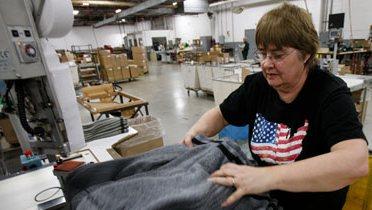Donald Trump gained fame as an employer of apprentices on his TV show, “The Apprentice.” Now president, he’s expressed his support for the highly effective and collaborative German apprenticeship model, which he praised recently in his meeting with German Chancellor Angela Merkel.
In addition, President Trump’s recent “skinny budget” has positive words for apprenticeship.
And before that, Trump replied, “let’s go for that 5 million,” to Salesforce CEO Marc Benioff challenging him to create 5 million apprenticeships in the next five years.
Could it be that apprenticeship is an old idea with new life in it?
The U.S. Department of Labor has long offered a flexible “Registered Apprenticeship” program that offers paid training and a nationally-recognized credential, making it a bit different from the TV model.
Given that format, the registered apprenticeship approach has garnered solid bipartisan support because it offers benefits for both workers and employers. For workers, it offers a chance to gain skills and income now, while preparing for a career. For employers, apprenticeships offer a variety of benefits, some not well understood.
For example, apprenticeships stand out as a way that companies can align their workforce strategies with their innovation strategies. They provide workers with both practical skills and an understanding of fundamental principles. Because apprentices understand the principles behind the work they are doing, they are often more adept at problem-solving, can adapt to new technologies, and can operate with less supervision than employees who are not apprentice graduates.
Thus, apprenticeships are not just a way of financing education. Rather, apprenticeship also reflects a distinct philosophy of education—that education is most effective when it integrates both practical skills and an understanding of fundamental principles.
For example, at a Siemens factory, an apprentice was able to figure out how to set up a job that had stymied his own mentors. He fabricated three new metal components to use in the setup of a machine, something he was able to do because he understood principles of physics and was able to write the code that told the machine tool what to do.
At Dartmouth-Hitchcock Medical Center, meanwhile, creating an apprenticeship program for medical assistants (MAs) was a necessary step in in the adoption of an innovative team-based care approach at the hospital.
Are these just one-off anecdotes? Actually no: These insights reflect a systematic exploration I conducted with my former colleagues at the Department of Commerce Office of the Chief Economist, “The Benefits and Costs of Apprenticeships: A Business Perspective.”
Our report is based on data from 13 leading businesses and intermediaries, including a hospital, a pharmacy chain, and an advanced manufacturer.
Our conclusion was this: businesses in a variety of industries can benefit from apprenticeships. In addition to the large-company examples mentioned above, apprenticeships can help small companies innovate as well. For example, apprenticeships offered jointly by construction firms and the North American Building Trades Union allow small firms to keep up with new developments in technology. Joint training centers have staff that ensure that new skills (e.g., installing fiber optic cable or solar panels) are incorporated into apprentice training and continuing education.
Also, the benefits of apprenticeship to the firms we studied were even greater than the firms had realized, according to our analysis of company data. That is, even these leaders in apprenticeships are not fully accounting for all the benefits of their apprenticeship programs.
Along these lines, our analysis found that Siemens USA obtains at least a 50 percent rate of return on its apprenticeship program, as compared to hiring machinists off the street. Most of the gains stem from the way that apprenticeships allow Siemens to more flexibly fill its capacity in Charlotte, NC. Apprentice graduates’ flexibility helps the plant make full use of spare capacity, when available, allowing the plant to seek generator repair work. Because Siemens’ apprentice graduates have a strong grasp of the principles of their work, they are particularly well suited for tasks like repair work, which involve more judgment than do standard projects. One year of this additional capacity is worth an amount similar to the cost of a worker’s apprenticeship program.
Dartmouth-Hitchcock Medical Center found that its Medical Assistant apprenticeship program nearly paid for itself within the first year. The program had an internal rate of return of 40 percent compared to using overtime with existing medical staff, and it was essential to a major expansion and re-organization of its provision of medical services. Reducing the long-term use of overtime also helped relieve staff burnout and turnover, while quality of care remained high after the MA apprentices were introduced.
Our report thus shows that companies may be missing an opportunity: The metrics they use don’t capture the full benefit of investing in workers. In our experience, when firms analyze the benefits of having workers who have both conceptual knowledge and practical skills, they find these benefits are surprisingly high. The report shows companies how they can use data they already have to look at the returns to investing in apprenticeships. That is, firms can use our analysis to help them evaluate investments in their workforce in the same way they evaluate investments in marketing or in acquiring another firm.
In any event, the takeaway is clear: the benefits of apprenticeships amount to a potential win-win-win—for companies, for workers, and for communities—that can help all three stay strong and compete through creativity, flexibility, and good jobs. Maybe Donald Trump, who famously produced “The Apprentice,” will now help bring real-life apprenticeship to scale in America.






Commentary
Will Trump be the one to take apprenticeships to scale?
April 7, 2017